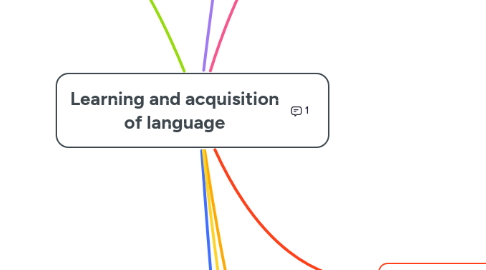
1. Names: Rivas Arias, Melissa Lizeth Urias Flores, Wilber Ernesto
2. Theoretical Approaches to L1 Acquisition
2.1. Innatism
2.1.1. Children are biotically programed for language and language develops in the child. Environment is other point that we have to take in consideration. Children are born with innate ability to discover for themselves.
2.2. Behaviorism
2.2.1. Language learners is the result of Imitation, practice, feedback and habit formation.
3. Characteristics of the language of children
3.1. predictability
3.1.1. There are predicable patterns in the L1 development and their L1 developmental patterns are related to their cognitive development.
3.2. learning through imitation
3.2.1. They consider a strech relation through the words that they use and the meaning they give.
3.3. creativity
3.3.1. Children are using the entire brain in order to have an effective communication they come up with their own rules sometimes.
4. Before First Words
4.1. The Earliest Vocalization
4.1.1. they manifest this by crying that means that they don't feel comfortable or that they are hungry based that when they are babies these are the prior attention that they need.
4.1.2. When babys start Cooing or gurgling this is a signal of Satisfaction or happines that they have could have different interpretation also that they feel comfortable where they are or position they are in the moment.
4.2. Babbling
4.2.1. They use it to start a reflect of the language that they are learning.
5. L1 Developmental Sequences
5.1. Acquisition of Grammatical morphemes
5.1.1. Through the tests, children demonstrate that they know the rules for the formation of plural and simple past in English.
5.2. Acquisition of Negation
5.2.1. Stage 1: ‘no’
5.2.2. Stage 2: subject + no
5.2.3. Stage 3: auxiliary or modal verbs (do/can) + not.
5.2.4. Stage 4: correct form of auxiliary verbs (did/doesn’t/is/are) + not
5.3. Acquisition of Questions
5.3.1. Order of the occurrence of wh- question words. “What” “Where” and “who” “Why” “How” and “When”
6. Development of Metalinguistic Awareness
6.1. Metalinguistic awareness refers to the ability to treat language as an object, separate from the meaning it conveys.
6.1.1. They see words represented by letters on a page and start to discover that words and sentences have multiple meaning.
